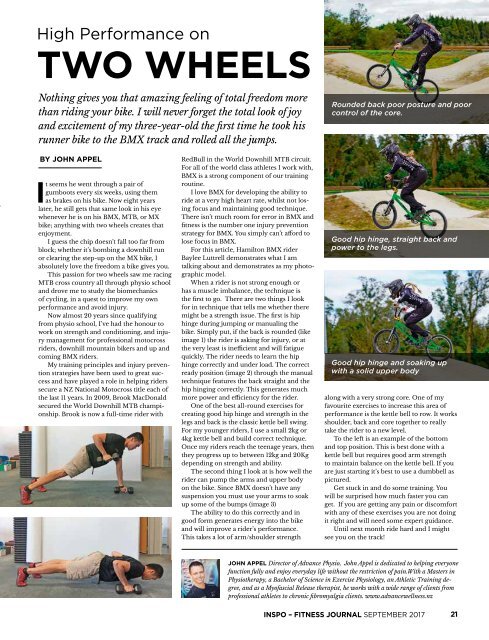INSPO Fitness Journal September 2017
Everything from nutrition, beauty, home and workplace wellbeing to health, performance – and so much more.
Everything from nutrition, beauty, home and workplace wellbeing to health, performance – and so much more.
You also want an ePaper? Increase the reach of your titles
YUMPU automatically turns print PDFs into web optimized ePapers that Google loves.
High Performance on<br />
TWO WHEELS<br />
Nothing gives you that amazing feeling of total freedom more<br />
than riding your bike. I will never forget the total look of joy<br />
and excitement of my three-year-old the first time he took his<br />
runner bike to the BMX track and rolled all the jumps.<br />
Rounded back poor posture and poor<br />
control of the core.<br />
BY JOHN APPEL<br />
It seems he went through a pair of<br />
gumboots every six weeks, using them<br />
as brakes on his bike. Now eight years<br />
later, he still gets that same look in his eye<br />
whenever he is on his BMX, MTB, or MX<br />
bike; anything with two wheels creates that<br />
enjoyment.<br />
I guess the chip doesn’t fall too far from<br />
block; whether it’s bombing a downhill run<br />
or clearing the step-up on the MX bike, I<br />
absolutely love the freedom a bike gives you.<br />
This passion for two wheels saw me racing<br />
MTB cross country all through physio school<br />
and drove me to study the biomechanics<br />
of cycling, in a quest to improve my own<br />
performance and avoid injury.<br />
Now almost 20 years since qualifying<br />
from physio school, I’ve had the honour to<br />
work on strength and conditioning, and injury<br />
management for professional motocross<br />
riders, downhill mountain bikers and up and<br />
coming BMX riders.<br />
My training principles and injury prevention<br />
strategies have been used to great success<br />
and have played a role in helping riders<br />
secure a NZ National Motocross title each of<br />
the last 11 years. In 2009, Brook MacDonald<br />
secured the World Downhill MTB championship.<br />
Brook is now a full-time rider with<br />
RedBull in the World Downhill MTB circuit.<br />
For all of the world class athletes I work with,<br />
BMX is a strong component of our training<br />
routine.<br />
I love BMX for developing the ability to<br />
ride at a very high heart rate, whilst not losing<br />
focus and maintaining good technique.<br />
There isn’t much room for error in BMX and<br />
fitness is the number one injury prevention<br />
strategy for BMX. You simply can’t afford to<br />
lose focus in BMX.<br />
For this article, Hamilton BMX rider<br />
Baylee Luttrell demonstrates what I am<br />
talking about and demonstrates as my photographic<br />
model.<br />
When a rider is not strong enough or<br />
has a muscle imbalance, the technique is<br />
the first to go. There are two things I look<br />
for in technique that tells me whether there<br />
might be a strength issue. The first is hip<br />
hinge during jumping or manualing the<br />
bike. Simply put, if the back is rounded (like<br />
image 1) the rider is asking for injury, or at<br />
the very least is inefficient and will fatigue<br />
quickly. The rider needs to learn the hip<br />
hinge correctly and under load. The correct<br />
ready position (image 2) through the manual<br />
technique features the back straight and the<br />
hip hinging correctly. This generates much<br />
more power and efficiency for the rider.<br />
One of the best all-round exercises for<br />
creating good hip hinge and strength in the<br />
legs and back is the classic kettle bell swing.<br />
For my younger riders, I use a small 2kg or<br />
4kg kettle bell and build correct technique.<br />
Once my riders reach the teenage years, then<br />
they progress up to between 12kg and 20Kg<br />
depending on strength and ability.<br />
The second thing I look at is how well the<br />
rider can pump the arms and upper body<br />
on the bike. Since BMX doesn’t have any<br />
suspension you must use your arms to soak<br />
up some of the bumps (image 3)<br />
The ability to do this correctly and in<br />
good form generates energy into the bike<br />
and will improve a rider’s performance.<br />
This takes a lot of arm/shoulder strength<br />
Good hip hinge, straight back and<br />
power to the legs.<br />
Good hip hinge and soaking up<br />
with a solid upper body<br />
along with a very strong core. One of my<br />
favourite exercises to increase this area of<br />
performance is the kettle bell to row. It works<br />
shoulder, back and core together to really<br />
take the rider to a new level.<br />
To the left is an example of the bottom<br />
and top position. This is best done with a<br />
kettle bell but requires good arm strength<br />
to maintain balance on the kettle bell. If you<br />
are just starting it’s best to use a dumbbell as<br />
pictured.<br />
Get stuck in and do some training. You<br />
will be surprised how much faster you can<br />
get. If you are getting any pain or discomfort<br />
with any of these exercises you are not doing<br />
it right and will need some expert guidance.<br />
Until next month ride hard and I might<br />
see you on the track!<br />
JOHN APPEL Director of Advance Physio, John Appel is dedicated to helping everyone<br />
function fully and enjoy everyday life without the restriction of pain.With a Masters in<br />
Physiotherapy, a Bachelor of Science in Exercise Physiology, an Athletic Training degree,<br />
and as a Myofascial Release therapist, he works with a wide range of clients from<br />
professional athletes to chronic fibromyalgia clients. www.advancewellness.nz<br />
<strong>INSPO</strong> – FITNESS JOURNAL SEPTEMBER <strong>2017</strong><br />
21


















